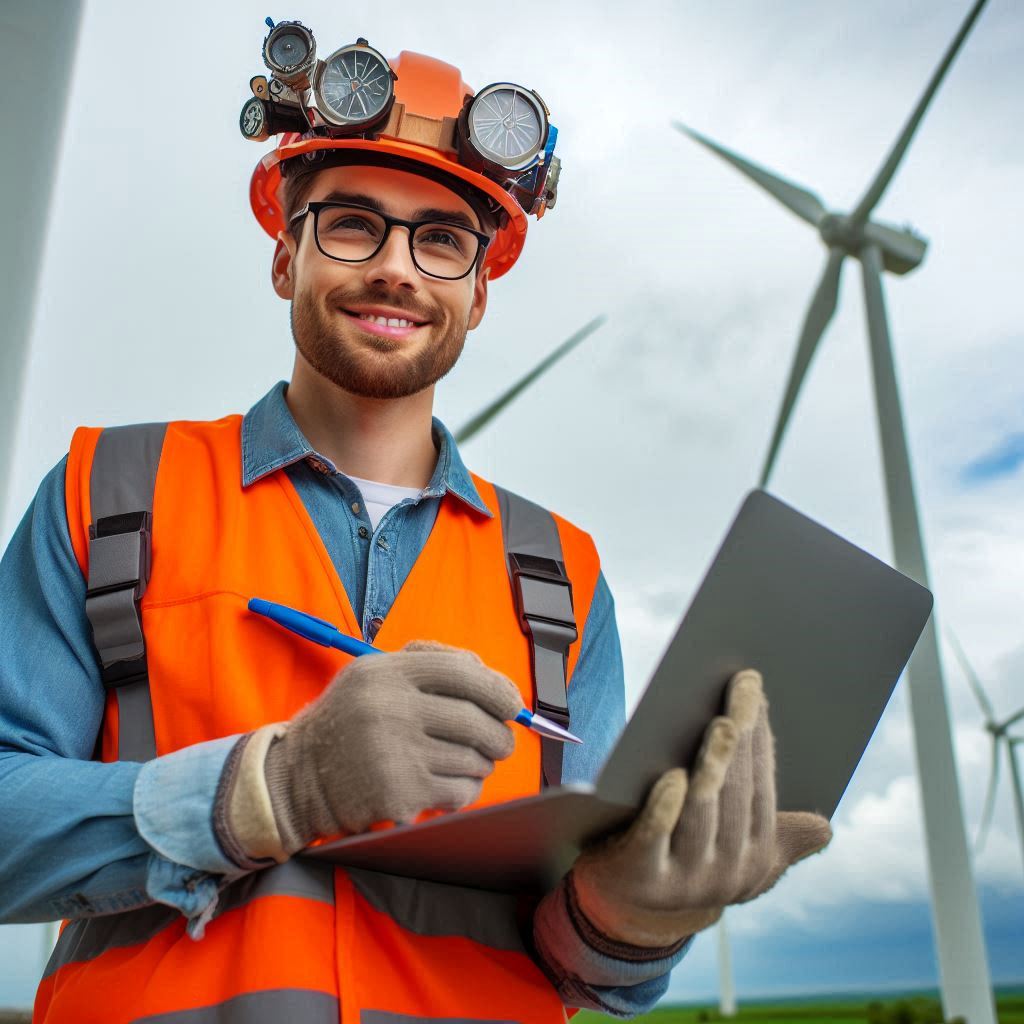Introduction
Wind turbine technicians are essential for maintaining and repairing wind turbines, ensuring they operate efficiently and reliably.
Their job involves a range of critical tasks, such as inspecting turbine components, performing mechanical and electrical repairs, and troubleshooting system issues.
Given the nature of their work, which often includes working at significant heights, handling heavy machinery, and managing complex electrical systems, safety is a top priority.
The importance of safety guidelines in the workplace cannot be overstated.
Adhering to established safety protocols is crucial for preventing accidents and injuries.
Wind turbine technicians face numerous hazards, including falls, electrical shocks, and equipment malfunctions.
To mitigate these risks, safety guidelines are put in place to protect technicians and ensure a secure work environment.
Essential safety guidelines include the use of personal protective equipment (PPE) such as helmets, harnesses, gloves, and safety glasses.
These items help safeguard technicians from potential hazards and are mandatory for their protection.
Additionally, following lockout/tagout procedures is vital for preventing accidental machine start-ups during maintenance work.
Properly securing equipment and isolating energy sources helps avoid unexpected accidents.
Regular safety inspections and maintenance of equipment are also critical.
Overview of Wind Turbine Technician Safety Guidelines
OSHA Guidelines for Working at Heights
OSHA guidelines are crucial for safety when working at heights.
Technicians must use fall protection systems to prevent accidents.
Safety harnesses, lanyards, and guardrails are essential for securing workers.
OSHA requires that all fall protection equipment be properly maintained and inspected regularly.
Technicians should receive training on how to use fall protection gear correctly.
They must also ensure that work platforms and ladders are stable and secure.
Adhering to OSHA‘s height safety regulations reduces the risk of falls and injuries.
Regular safety audits and adherence to safety protocols are essential for maintaining a safe work environment.
Proper Use of Personal Protective Equipment (PPE)
The proper use of personal protective equipment (PPE) is critical for wind turbine technicians.
PPE includes hard hats, safety glasses, gloves, and hearing protection.
Technicians must wear these items to protect against physical injuries and hazards.
Safety glasses shield the eyes from flying debris, while gloves protect hands from sharp objects and chemicals.
Hard hats guard against falling objects, and hearing protection prevents hearing loss from loud machinery.
Technicians should ensure their PPE fits correctly and is in good condition.
Regular inspections and replacements of damaged PPE are necessary.
Following PPE guidelines helps prevent injuries and ensures a safer working environment.
Safety Precautions for Working with Electrical Components
Safety precautions for working with electrical components are vital.
Technicians must follow strict procedures to avoid electrical shocks and burns.
They should de-energize electrical systems before beginning any maintenance work.
Lockout/tagout procedures ensure that electrical sources are safely disconnected.
Technicians must use insulated tools and wear appropriate PPE when handling electrical components.
Proper training on electrical safety protocols is essential.
They should also inspect equipment for defects before use.
Following these safety practices helps prevent electrical accidents and ensures safe operations.
Adhering to electrical safety guidelines protects technicians from injuries and contributes to a safer workplace.
Therefore, adhering to OSHA guidelines for working at heights.
Using personal protective equipment correctly, and following electrical safety precautions are essential for wind turbine technicians.
These safety measures prevent accidents and injuries.
By ensuring proper use of fall protection, PPE, and electrical safety protocols, technicians can maintain a safe work environment and protect themselves from potential hazards.
Importance of Regular Safety Training
Ongoing Training to Keep Up with Industry Standards
Wind turbine technicians must engage in ongoing training to stay current with industry standards.
The wind energy sector evolves rapidly, with new technologies and safety protocols emerging regularly.
Continuous training ensures technicians are aware of the latest safety procedures and technical advancements.
This ongoing education helps maintain high safety standards and operational efficiency.
Technicians should participate in regular refresher courses and industry seminars.
These sessions provide updates on best practices and regulatory changes.
Training programs often cover new equipment, improved techniques, and recent safety developments.
Staying informed about these updates minimizes risks and enhances job performance.
Additionally, ongoing training helps technicians adapt to evolving safety regulations.
Industry standards can change based on new research, technology, or incident investigations.
By keeping up with these changes, technicians ensure they adhere to current safety requirements, reducing the likelihood of accidents or injuries.
Technicians who continuously update their skills are better prepared to handle complex situations.
They can effectively manage new equipment and technologies, improving overall safety.
Ongoing training also reinforces the importance of safety protocols, helping technicians integrate these practices into their daily routines.
Importance of Re-training After Accidents or Near Misses
Re-training after accidents or near misses is crucial for reinforcing safety practices.
When an accident or near miss occurs, it highlights areas needing improvement.
Re-training helps address these gaps and prevent future incidents.
Technicians must review what went wrong and learn from these experiences.
Re-training should focus on the specific issues identified during the incident.
This targeted approach ensures that technicians understand the exact safety protocols or procedures that need reinforcement.
By addressing the root causes of accidents or near misses, technicians can improve their safety practices.
Furthermore, re-training after an incident can restore confidence among technicians.
It reassures them that safety is a priority and that the organization is committed to addressing potential hazards.
This can improve morale and reinforce a culture of safety within the team.
Implementing re-training programs also demonstrates a proactive approach to safety.
It shows that the organization values its employees and is dedicated to their well-being.
This commitment can enhance trust and cooperation among technicians, contributing to a safer work environment.
Read: Continuing Education for Radiologic Technologists
Emergency Response Protocols
When dealing with wind turbine technician safety, having clear emergency response protocols in place is crucial.
It is important to establish a chain of command and communication channels during emergencies.
Technicians should be trained on how to quickly and safely respond to different types of emergencies.
Regular emergency drills should be conducted to ensure that all team members are prepared for any situation.
Having designated assembly points in case of evacuation is essential for a coordinated response.
Procedures for Responding to Electrical or Mechanical Failures
Electrical and mechanical failures are common issues that wind turbine technicians may face.
In the event of an electrical failure, technicians should immediately shut off power to the turbine.
Proper lockout/tagout procedures must be followed to prevent accidental re-energization.
Technicians should be equipped with personal protective equipment when dealing with electrical or mechanical failures.
Documenting the details of the failure and the steps taken to address it is important for future reference.
Evacuation Plans for Extreme Weather Events
Extreme weather events pose a significant threat to wind turbine technicians working at heights.
Establishing evacuation plans for extreme weather events such as hurricanes or thunderstorms is crucial.
Technicians should be trained on how to safely evacuate the turbine in case of severe weather.
Monitoring weather forecasts regularly and having a system in place to alert technicians of impending danger is key.
Having designated shelters or safe locations for technicians to seek refuge during extreme weather events is essential.
In essence, wind turbine technician safety guidelines should include comprehensive emergency response protocols.
Procedures for addressing electrical or mechanical failures, and evacuation plans for extreme weather events.
By prioritizing safety and preparedness, technicians can minimize risks and ensure a safe working environment.
Read: Common Mistakes in Quality Control Inspections

Importance of Proper Equipment Maintenance
Regular Inspections of Tools and Equipment
Regular inspections of tools and equipment are crucial for maintaining safety in wind turbine maintenance.
Technicians should conduct these inspections before each use to identify potential issues.
Check for any signs of wear, damage, or malfunctioning parts.
Ensure that all tools and equipment are functioning correctly and safely.
Report and address any defects immediately to prevent accidents.
Regular maintenance of tools also extends their lifespan and ensures optimal performance.
Follow the manufacturer‘s recommendations for inspection intervals and maintenance procedures.
Implement a checklist for routine inspections to standardize the process and ensure thorough evaluations.
Keep detailed records of all inspections and maintenance activities.
This documentation helps track the condition of equipment over time and supports safety audits.
Keeping Work Areas Clean and Organized to Prevent Accidents
A clean and organized work area is essential for preventing accidents and maintaining safety.
Technicians should keep their workspaces free from clutter and debris.
Ensure that all tools and materials are stored properly when not in use.
Remove any obstacles or hazards from walkways and working surfaces to avoid tripping accidents.
Regularly clean up spills and other potential slip hazards.
Establish a system for organizing tools and equipment to facilitate easy access and reduce the risk of accidents.
Use proper storage solutions, such as toolboxes and shelving, to keep items in their designated places.
Encourage team members to follow these practices consistently to maintain a safe working environment.
Implementing these practices helps reduce the risk of injuries and ensures a more efficient and safer workspace.
Generally, regular inspections of tools and equipment, along with maintaining clean and organized work areas, are vital for ensuring safety.
Technicians should adhere to established inspection schedules, promptly address any issues, and keep their workspaces free of hazards.
These practices contribute to a safer working environment and enhance overall efficiency in wind turbine maintenance.
Read: Best Online Courses for CAD Technician Training
See Related Content: Preparing for a Systems Engineering Certification Exam
Importance of good communication
Clear Communication Between Team Members
Clear communication is vital for ensuring safety among wind turbine technicians.
Effective communication helps prevent misunderstandings and accidents.
Technicians must share critical information about tasks and potential hazards.
Regular briefings and updates ensure that all team members are aware of ongoing activities.
Using standard communication protocols and safety signals reduces the risk of errors.
Team members should confirm that they understand instructions and safety procedures.
Open lines of communication foster a collaborative work environment.
Technicians should use radios or other communication devices to stay connected during operations.
Encouraging a culture of openness helps in identifying and addressing safety concerns promptly.
Effective communication enhances teamwork and supports overall safety on the job.
Reporting Any Safety Concerns to Supervisors Immediately
Reporting safety concerns to supervisors immediately is essential for maintaining a safe work environment.
Technicians should promptly inform their supervisors of any potential hazards or unsafe conditions.
Early reporting allows for quick resolution of issues before they escalate.
Technicians must be aware of the proper channels and procedures for reporting concerns.
Supervisors rely on timely information to assess risks and implement corrective measures.
Reporting unsafe conditions helps in preventing accidents and injuries.
Technicians should not hesitate to raise concerns, regardless of their severity.
A proactive approach to safety ensures that all team members can work in a secure environment.
Immediate reporting contributes to a culture of safety and accountability.
In summary, clear communication and prompt reporting of safety concerns are crucial for wind turbine technician safety.
Effective communication among team members prevents misunderstandings and supports safety protocols.
Reporting hazards to supervisors ensures that issues are addressed quickly and efficiently.
These practices contribute to a safer work environment and enhance overall team performance.
By prioritizing clear communication and immediate reporting, technicians can uphold high safety standards and protect themselves and their colleagues.
Transform Your Career Today
Unlock a personalized career strategy that drives real results. Get tailored advice and a roadmap designed just for you.
Start NowRead: CAD Technician Job Market: Trends and Insights
Find Out More: Top Environmental Engineering Companies to Work For
Importance of Physical Fitness
Maintaining physical fitness is crucial for wind turbine technicians to perform their job safely and effectively.
Proper physical fitness ensures that technicians have the strength, endurance, and flexibility to handle the physical demands of the job.
Importance of Being in Good Physical Shape for Climbing and Lifting
Wind turbine technicians are often required to climb tall towers and lift heavy equipment.
Being in good physical shape reduces the risk of injury while performing these tasks.
Strong muscles and good cardiovascular fitness are essential for climbing and lifting safely.
Training Programs for Staying in Shape for the Job
There are several training programs that wind turbine technicians can follow to stay in shape for their job.
Cardiovascular training, such as running or cycling, can improve endurance for climbing towers.
Strength training, including weightlifting and bodyweight exercises, can build the muscle needed for lifting heavy equipment.
Flexibility exercises, like yoga or stretching routines, can improve range of motion and reduce the risk of injuries.
It is important for technicians to incorporate a variety of exercises into their training routine to ensure overall fitness.
Regular training and maintaining physical fitness will not only improve job performance but also reduce the risk of accidents and injuries on the job.
Ultimately, physical fitness plays a crucial role in the safety and effectiveness of wind turbine technicians.
By prioritizing physical fitness through training programs and regular exercise, technicians can ensure that they are prepared for the physical demands of their job.
Discover More: Navigating the Job Market as a Robotics Engineer
Conclusion
Adhering to safety guidelines is paramount for wind turbine technicians, given the inherent risks of the job.
Safety protocols are designed to protect workers from various hazards, including working at significant heights, handling complex machinery, and dealing with challenging weather conditions.
Proper use of personal protective equipment (PPE), such as harnesses, helmets, and gloves, is crucial in minimizing the risk of accidents and injuries.
Consistent safety training and adherence to established procedures are essential for maintaining a safe working environment.
Technicians must regularly review and follow safety protocols to prevent incidents and ensure their own well-being.
Vigilance and adherence to safety practices foster a culture of safety, reducing the likelihood of accidents and enhancing overall job performance.
Encouraging all technicians to prioritize safety in their daily tasks is critical.
A strong commitment to safety not only prevents workplace accidents but also supports the efficiency and success of wind energy projects.
By making safety a top priority, technicians contribute to a more secure, productive work environment and help ensure the long-term success of renewable energy initiatives.
[E-Books for Sale]
The Big Book of 500 High-Paying Jobs in America: Unlock Your Earning Potential
$19.99 • 500 High-Paying Jobs • 330 pages
Explore 500 high-paying jobs in America and learn how to boost your career, earn more, and achieve success!
See All 500 High-Paying Jobs of this E-Book
1001 Professions Without a Degree: High-Paying American Jobs You Can Start Now
$19.99 • 1001 Professions Without a Degree • 174 pages
Discover 1001 high-paying jobs without a degree! Unlock career tips, skills, and success strategies for just $19.99!




